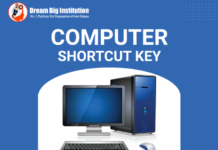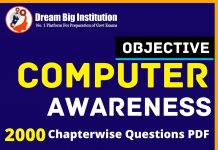Hello Dear Aspirants,
Full Form of Computer: A computer is an electronic machine that accepts data from the user, processes the data by performing calculations and operations on it and generates the desired outcome or result. The computer is derived from the Latin word ‘computerae’ which means ‘to compute’. The full form of the Computer is Common Operating Machine Purposely Used for Technological and Educational Research.
Table of Contents
What is the full form of Computer?
The full form of computer is given below:
- C = Common
- O = Operating
- M = Machine
- P = Particularly
- U = Used
- T = Trade
- E = Education
- R = Research
The full form of a Computer is a “Common Operating Machine Purposely Used for Technological and Educational Research”. The term was coined in the mid-20th century when computers were first developed. Initially, computers were used for scientific and military research, but with time, their usage became widespread. The name ‘computer’ was given to these machines to indicate their purpose, which was to compute and process large amounts of data.
| Computer = Arithmetic Logical Unit + Control unit |
ALU: Arithmetic Logical Unit is used to carry out arithmetic (addition, subtraction, division, and multiplication) and logical operation.
CU: Control unit is used to change the order of operations in response to stored information
How does a computer work?
A computer is an electronic device that operates on a set of instructions called software. The computer hardware comprises several components, including the Central Processing Unit (CPU), Random Access Memory (RAM), Hard Disk Drive (HDD), and Input-Output devices. When a user gives an instruction, the CPU processes it and retrieves the required data from the RAM or HDD. The output is then displayed on the screen or through a speaker.
Advancements in Computing Technology
Since the inception of computers, computing technology has advanced tremendously. The first computers were massive and expensive, and they had limited capabilities. However, with time, computers have become more compact, affordable, and efficient. Today, we have computers in various forms, including laptops, desktops, tablets, and smartphones. The computing power of modern-day computers has increased significantly, making it possible to perform complex tasks such as Artificial Intelligence and Machine Learning.
What types of computers are there?
The way a computer performs particular activities can be used to classify it. The following are the basic categories:
- Digital Computer
- Analog Computer
- Hybrid Computer
Generations of Computer
First-generation computer :
These computers were large and expensive and required specialized technicians to operate and maintain them. They were primarily used for military and scientific applications, such as calculating artillery firing tables and performing atomic energy calculations.
The first generation of computers was characterized by their use of vacuum tubes and their reliance on punched cards for input and output. They were also relatively slow, with processing speeds measured in milliseconds. Despite their limitations, the first generation of computers laid the foundation for the development of modern computers and revolutionized the way we process and store information.
Second-generation of computer
The main characteristics of second-generation computers were:
Use of transistors: The use of transistors in second-generation computers made them faster, more reliable, and more energy efficient than first-generation computers, which used vacuum tubes.
Magnetic storage: Second-generation computers used magnetic storage devices such as magnetic disks and tapes to store data. These devices could store large amounts of data and were more reliable than the punched card storage used in first-generation computers.
Ferrite core memory: Ferrite core memory was used as the main memory in second-generation computers. It was faster and more reliable than the magnetic drums used in first-generation computers.
Formal languages: Second-generation computers used formal languages such as COBOL and FORTRAN for programming, which made it easier for programmers to write code.
Time-sharing: Second-generation computers introduced the concept of time-sharing, which allowed multiple users to access the computer at the same time. This made it possible for computer users to work on the same computer simultaneously, increasing productivity.
Overall, second-generation computers were a significant improvement over first-generation computers and laid the foundation for the development of modern computers.
Third-generation of computer
The third generation covers the years 1964 to 1977. In its place, transistors were replaced by integrated circuit (IC) chips. Transistors, registers, and capacitors can all be found in large quantities on a single Integrated Circuit (IC) chip.
IBM-360 and VAX-750 are two examples of third-generation computers.
Fourth-generation of computer
The fourth generation spans the years 1978 through 1990. VLSI was used in the fourth generation. VLSI, in its full definition, is an extremely large-scale integration. VLSI refers to an integrated circuit chip with more than 1000 embedded components. This generation produced personal computers.
Apple and IBM both offer fourth-generation products as examples.
Fifth-generation of computer
The fifth generation spans the years 1991 to the present. Uncertain ULSI chips were introduced in the fifth generation. Ultra Large Scale Integration is the full name for this technology. New technologies are introduced in the fifth generation, such as machine learning and artificial intelligence (AI).
Full Form Of Computer: List Of Computer-Related Full Forms
Candidates preparing for Competitive exams should aware of some computer terms. These terms can directly ask in the online examination.
| Abbreviation | Full-Form |
| COMPUTER | Common Operating Machine Purposely Used for Technological and Educational Research |
| ROM | Read-Only Memory |
| CPU | Central Processing Unit |
| URL | Uniform Resource Locator |
| USB | Universal Serial Bus |
| VIRUS | Vital Information Resource Under Siege |
| TCP | Transmission Control Protocol |
| UPS | Uninterruptible Power Supply |
| SATA | Serial Advanced Technology Attachment |
| RAM | Random Access Memory |
| SMPS | Switched-Mode Power Supply |
| CD | Compact Disc |
| DVD | Digital Versatile Disc |
| CRT | Cathode Ray Tube |
| DEC | Digital Equipment Corporation |
| SAP | System Application and Products |
| PNG | Portable Network Graphics |
| IP | Internet Protocol |
| GIS | Geographical Information system |
| DDS | Digital Data Storage |
| CAD | Computer-Aided Design |
| ACPI | Advanced Configuration and Power Interface |
| AGP | Accelerated Graphics Port |
| APM | Advanced Power Management |
| APIPA | Automatic Private Internet Protocol Addressing |
| HTTP | HyperText Transfer Protocol |
| HTTPS | HyperText Transfer Protocol Secure |
Computer Memory
- KB- Kilobyte (this is the smallest storage unit)
- MB- MegaByte
- GB- GigaByte
- TB- TeraByte
- PB- PentaByte
- EB- EXAByte
- ZB- ZetaByte
Computer courses
- ADCA– Advance Diploma in Computer Application
- BCA- Bachelor of Computer Application
- COPA- Computer Operator cum Programming Assistant
- CSE- Computer Science Engineering
- DCA- Diploma in Computer Application
- DCE- Diploma in Computer Engineering
- IT- Information Technology
- MCA- Master of Computer Application
Computer Networking
- 2G- 2nd Generation
- 3G- 3rd Generation
- 4G- 4th Generation
- 5G- 5th Generation
- CDMA full form- Code Division Multiple Access
- DNS- Domain Name System
- GPRS- General Packet Radio Service
- GSM- Global System for Mobile Communication
- HTML- HyperText Markup language
- IP- Internet Protocol
- ISP- Internet Service Provider
- SIM- Subscriber Identity Module
- URL- Uniform Resource Locator
- VPS- Virtual Private Server
- WAN- Wide Area Network
- WIFI- Wireless Fidelity
- WLAN- Wireless Local Area Network
- WWW- World Wide Web
Computer file formats
- 4K- 4000
- GIF- Graphical Interchangeable Format
- HD- High Definition
- MP3- MPEG Audio Layer 3
- MP4-
- UHD- Ultra High Definition
Digital Marketing Full form:
In digital marketing, the following terms are frequently used along with their full names:
- Search engine optimization (SEO) and pay-per-click (PPC)
- Click-Through Rate (CTR)
- Cost-Per-Click, or CPC
- Cost-Per-Action, or CPA
- Cost-Per-Mille, or CPM
- Cost-Per-Lead (CPL) and Return on Investment (ROI)
- Key Performance Indicator (KPI)
- Conversion rate optimization, or CRO
- A user interface, or UI, and user experience, or UX
- Click-Through Rate (CTR)
- API – Application Programming Interface
- SERP – Search Engine Results Page
- Search engine marketing, or SEM
- Social media marketing (SMM)
- Online Reputation Management, or ORM.
FAQ on Full Form of Computer
Q. What is the full form of BIOS ?
Ans: BIOS- Basic Input Output System
Q. What is the Full form of a Computer?
Ans: The full form of a Computer is a “Common Operating Machine Purposely Used for Technological and Educational Research”.
Q. What is the brain of computer?
Ans: CPU
The CPU is the brain of a computer, containing all the circuitry needed to process input, store data, and output results.
Thanks for Reading Full Form Of Computer: List Of Computer-Related Full Forms
Happy learning and keep Sharing!












